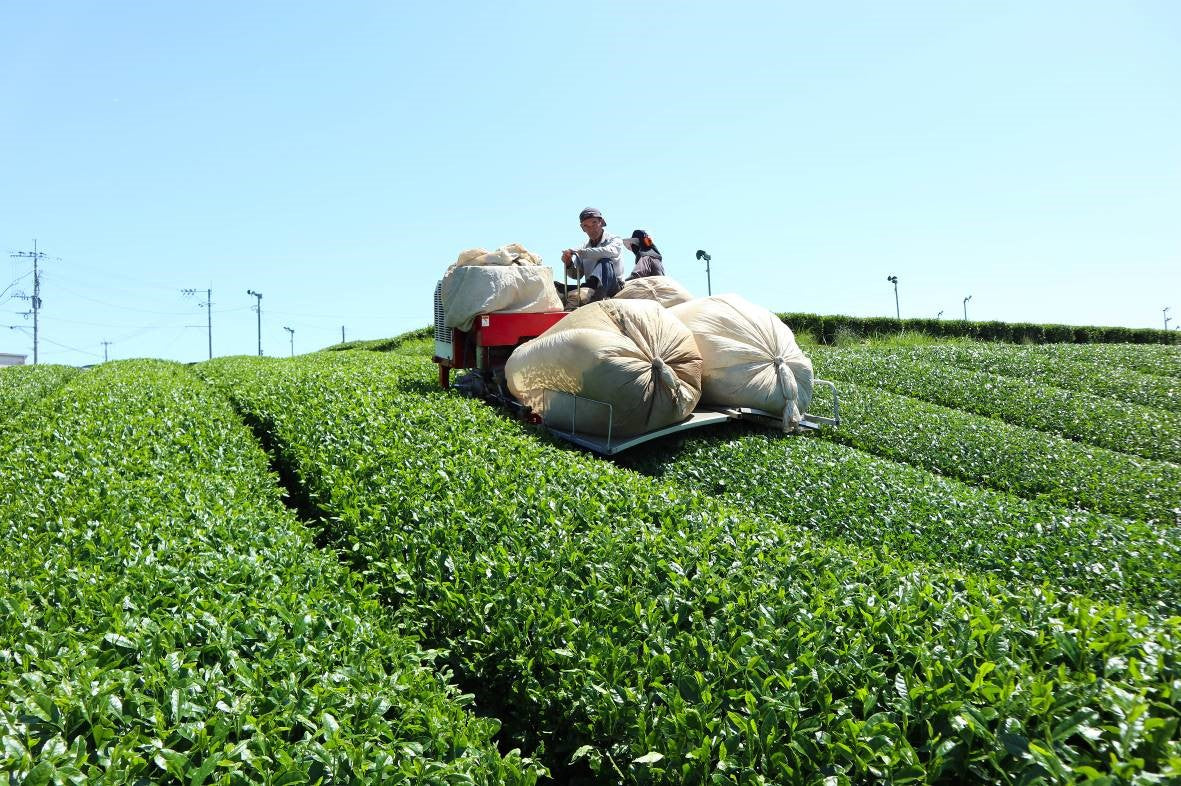
A Guide to Harvesting Tea Leaves: An Essential Process in Japanese Green Tea
As with all processes in crafting Japanese green tea, harvesting tea leaves is an intricate skill that takes years to master. Much of the year is dedicated to the elaborate systems associated with tea harvesting, and it’s an understatement to say that farmers devote their lives to learning and perfecting the traditional processes to properly harvest green tea. Tea lovers of all kinds should appreciate the passion that goes into green tea processing and harvesting as it’s no small feat!
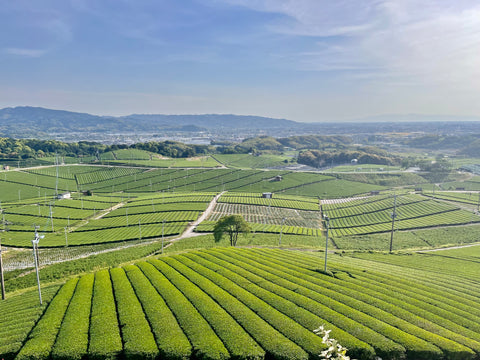 Tea Fields in Kyushu, Japan
Tea Fields in Kyushu, Japan
Japanese tea farmers have perfected specific harvesting processes unique to Japan. It’s among the most crucial part of the production process (along with steaming). Determining factors like the method of harvest (by hand or by machine), the exact moment when the leaves are picked, the weather, and the parts of the tea plant used, all determine the quality and different types of Japanese tea produced.
Want to learn more? Read on to take a deep dive into Japanese green tea harvesting and what makes this step key in determining the quality of popular Japanese tea like gyokuro, matcha, sencha, and kabusecha.
The Importance of Harvesting Tea Leaves
The quality of green tea significantly depends on harvesting methods. A producer can alter the flavor of the tea by harvesting it on different days, using a machine versus by hand, or by picking only certain leaves on the stem (for example, the top 3-5 newest leaves and bud that have grown in the season, or more mature leaves further down the stem of the plan). Tea harvesting only occurs a few times a year, and in the case of exceptional quality tea – just once a year. Farmers only have so many chances in their lifetime to see the results of their efforts. Unlike someone practicing a craft where they can make several iterations of their art in a day’s or week’s time, tea farmers truly only have one chance a year to strive to make their best teas.
Farmers must plan and strategize harvesting tea leaves to maximize yields and produce desired characteristics for each harvest – and they must keep a keen eye on the weather patterns. Elements like frost, early heat, too much rain, etc – all change the flavor of the tea and can change harvesting schedules. For example in 2023, Spring was quite warm and caused the tea bushes to sprout very quickly. Fast growing sprouts can be undesirable as the plants don’t have enough time to develop and concentrate flavor. Farmers responded and most of the country’s tea harvest was conducted earlier than usual.
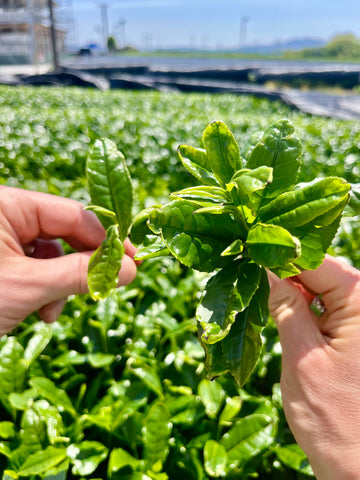 Freshly plucked Yabukita leaves
Freshly plucked Yabukita leaves
How is Green Tea Harvested?
Shincha: The First Harvest
In general, tea can be harvested up to three times a year. The most prized season is “shincha” (新茶) or “new tea” and is treasured. Many tea lovers wait the entire year just to try the first early spring harvest. Shincha is prized because the plants concentrate prized nutrients over the winter. It’s said that the freshest flavor and most refreshing aromas are found in the new growth in the first flush of Spring as the plants use their energy stores to send out new buds. Shincha is widely celebrated in Japan and there’s superstition that drinking nutritious shincha in the Spring will aide with good health throughout the year. Shincha is famed for its decadent balance of light sweetness, savory notes, a delectable umami flavor, and refreshing astringency.
It’s a race to get your hands on Shincha, as it can sell out before it's even harvested! Shincha harvest lasts only a few days in a year and generally begins at hachiju-hachiya (or, the 88th night of Spring in Japan). As soon as the sprouts mature enough, they must be picked right away. If the leaves continue growing, they become Sencha.
Nibancha: Second Harvest
The next harvest is nibancha (2nd flush), which can also be great quality. Many teas you’d use for daily drinking are made from nibancha. Second-flush tencha is also common, which may be used for blending quality matcha blends. Lastly, sanbancha, or 3rd flush, is often used for quality hojicha or lower-grade teas.
The 4th season of the year should really only be reserved for pruning tea plants in autumn and letting the plants rest. However, there are some innovative tea styles that make use of prunings and make delicious tea, also known as our favorite kyobancha – nothing is wasted! Fall is a critical season to prepare tea plants for the winter. Once fall arrives, many farmers begin preparing the soil and fertilizing the crop. The soil is enriched, and the pH balance is adjusted to encourage new root growth and promote the healthiest tea plants. Straw, bamboo husks, and dry leaves fertilize the soil and help it retain moisture.
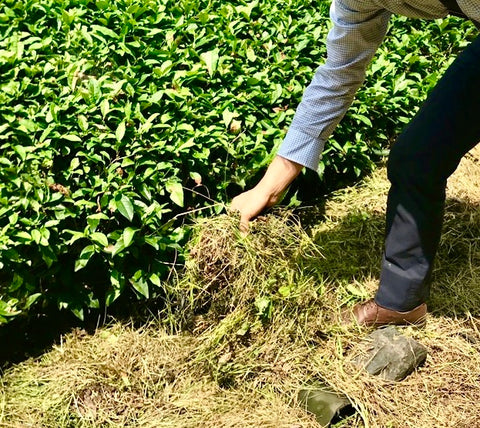 Wara straw compost for fertilizer
Wara straw compost for fertilizer
Green tea plants are also pruned during the fall months to ensure all the old leaves are removed and avoid interference with the new leaves of the spring harvest. Throughout the winter, tea plants will rest and absorb nutrients from the soil.
Harvesting at exactly the right time is essential to receive the most from tea crops. If farmers harvest too early, the yield will be small. Harvest too late, and the tea leaves will be less tender and pliable — if the leaves are too tough, and the quality will be compromised. Speed is vital to ensure the best quality. The leaves are exactly the right size and uniform to be picked when there are about three - five new leaves. Tea must be picked and processed extremely quickly, all at once — often in the same day! Tea producers will often take 24 hour shifts in the tea factory after the harvest arrives to ensure the quality does not diminish.
Different Harvesting Techniques
Machine Harvesting
The general mechanization of the tea harvests in Japan occurred in the second half of the 20th century, in order to help tea farmers cope with the decreasing numbers of tea pickers and rising labor costs (higher salaries). Relying on machines for harvest allows modern tea farmers to maintain a sufficient yield with a reduced staff number, while drastically reducing the time needed to harvest one field. In regions like Uji where the fields are small, or on sharp slopes, the trees are harvested with a handheld machine managed by two people, each person standing on one side of the rows of tea bushes.
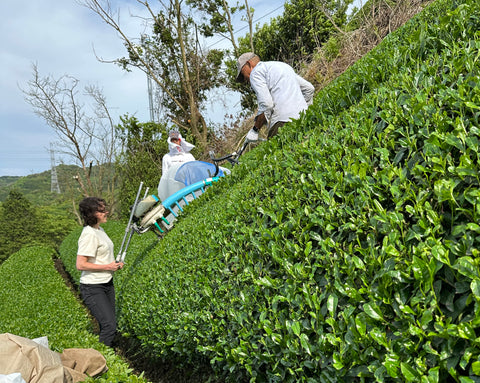 Mizuba founder, Lauren, harvests sencha with friends
Mizuba founder, Lauren, harvests sencha with friendsHandheld and motorized harvesting machines are often used when harvesting tea leaves. Tea plants are grown in rows, so motorized harvesters can easily navigate through the plants and quickly harvest leaves. It allows farmers to harvest tea faster but it can be less accurate and precise than a handheld tea harvester or picking by hand.
The machine is placed carefully on top of the tea trees to make sure that only the tender new spring leaves are harvested. If the machine is not set at the correct height, old, coarse leaves will be pruned from the trees, and they will give a bitter flavor to the fully refined Matcha after grinding. It takes true skill to use a harvesting machine, but the vast majority of tea farmers in Japan are incredibly talented!
The leaves are sucked into a ballooning fabric attached behind. A third person might follow to guide the bag in which the leaves are collected. By walking back and forth along the rows, two people can harvest a field in a few hours, with an efficiency 60 times higher than that of a tea picker.
However, the machine lacks a bit less precision compared to a skilled tea picker, so the trees need to have an even, regular pruning surface. In order to obtain this surface appropriate for the machine, the tea trees are pruned before the new buds come out to determine the height at which the trees will be mowed during harvest season. Buds and leaves then grow above that height, and what will be harvested later in the season are the tender new leaves that grew above the leveled surface of the trees. In this method, the tea trees are pruned before each harvest to fit the shapes of the machine.
In regions such as Kagoshima, where large fields spread out as far as the eye can see, the fields are harvested by tractors, which go down the long rows, needing only one person to guide the machine. This type of harvest needs flat lands and cannot be operated on sharp slanted slopes or small fields.
 A tea harvesting tractor suitable for flatter fields
A tea harvesting tractor suitable for flatter fields
Handpicking
Although mechanical harvests have taken precedence in modern Japan, we are fortunate to still benefit from the hard work of producers who continue to grow their teas traditionally, under shade canopies and with a hand-picking method at harvest time.Top-quality and specialty teas like ceremonial matcha and gyokuro are commonly handpicked. This method is the most time-consuming and expensive but produces the highest quality tea. Thousands of skilled workers from all over town gather once a year to help with harvesting tea leaves.
Handpicking takes extreme attention to detail, and each leaf is chosen carefully. Farmers pick the best leaves from each tea plant resulting in a more pleasant flavor and a delicate scent.
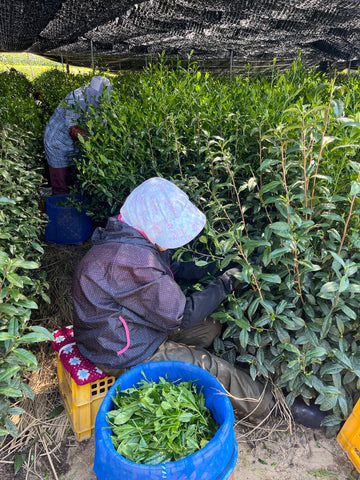 A seasoned harvester handpicks tea in Uji, Japan
A seasoned harvester handpicks tea in Uji, Japan
In the case of hand-picked fields, about 40 tea pickers can work from 6 am to 3 pm. Skilled workers may pick about 6-10 kg of leaves per day depending on the time of harvest. (Early in the harvest period, the leaves are still smaller, so that makes less quantity to harvest for the pickers).
It takes a lot of organization to prepare for a hand-picked harvest, as the producers need to “listen” to the tea fields, so that the leaves can be picked during the small window of time when they are not too small (to get enough yield), but not too big and coarse yet either (to avoid bitter flavors). This can be a hassle if there is a sudden change of weather, as it can push the harvest up (earlier than planned), or back, and everyone has to adapt to the unique circumstances each year. Also, farmers focusing on hand picked fields need to make sure that they grow several types of cultivars (type of tea leaf with different DNA), so that the harvest window can be made longer for all of their fields (early budding or late budding cultivars, etc). Indeed, if all the fields are ready for harvest at the same time, there are not enough hands and time to pick all the leaves during the short period when they have just the right size and tender texture.
In the case of hand-picked fields, each tender spring sprout is precious and the producers cannot afford to leave any behind. There is a myth about the “one bud, two leaves” harvests, but these are very rare. In fact, they are usually reserved for tourist picking events or for harvests meant for the few teas that will be entered in competitions. For most hand-picked harvest, the reality is that the workers break off the tender spring twigs at their base shooting from the mother leaf. The spring twigs are thin and supple, it is easy to tear them off by pinching them between three fingers. In this method, the pickers can end up with a bud and up to 5 tender spring leaves that will be sent to the tea factory.
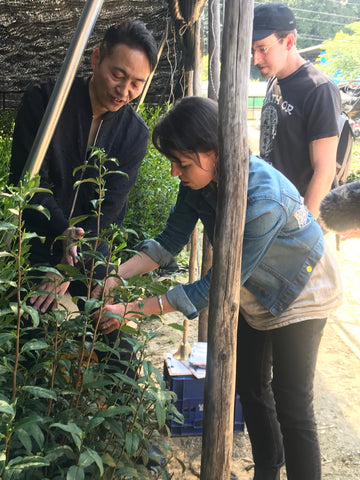 Lauren and Dan handpick Samidori tencha with award-winning producer, Tsuji san
Lauren and Dan handpick Samidori tencha with award-winning producer, Tsuji san
Even in a dimmer environment under shade, the pickers can clearly see which leaves are old and coarse, and which leaves are tender and new. They sit down in the rows, each with a few bushes to pick from, and start tearing the spring twigs from the trees all along the branches, from the ground up, so no new leaf is forgotten under the foliage.
After tearing clusters of new spring leaves, the pickers place them in a basket at their feet, which will be taken to be weighed at the tea factory nearby around mid-day for the first round of leaf processing. Often, the workers are not paid hourly, but by kg of leaves harvested during the day, so that is an incentive to work fast and efficiently, but it is also a negative factor in the eye of potential new pickers who know that they will be slow and will have a lower pay in exchange for their labor.
In addition, experienced tea pickers are an aging demographic and there are not many people willing to take their place. The lack of interest is a headache for the tea producers, who can struggle to find enough staff to help them harvest their fields.
One other headache is the fact that, although Matcha consumption has boomed around the world, this does not encompass sales of high quality hand-picked Tencha, which have not increased. In fact, Matcha made from high quality Tencha is expensive, and it is more and more a niche product, bought by Matcha aficionados willing to enjoy the best tea they can find while supporting their producers. (PS - thank you from the bottom of our hearts for your support of Mizuba Tea, so we can continue to support our farmers and producers working hard to preserve authentic Japanese tea heritage!)
 Tea-picking baskets ready for harvest
Tea-picking baskets ready for harvest
Comparing Harvesting by Hand Versus by Machine
One might have to be quite the tea sommelier to taste the difference between a hand-picked and mechanically harvested Tencha grown and produced in the same field by one tea farmer. However, if we were to compare hand-picked fields with mechanically harvested fields, there are some disparities that can justify the use of hand pickers over machines. In the case of hand-picked harvests, the trees go through less stressors (eg, only one harvest per year, not trimming before harvest to fit the shape of a machine). The plant's roots can spread deeply into the ground, allowing for a varied range of nutrients to be sourced from the soil and brought up to the leaves. (varied nutrients = rich flavor). As such, the trees are nurtured so that they can give 100% of their flavor potential at the peak of their health.
On the other hand, mechanically harvested fields go through several periods of cutting to fit the machines before each harvest. Cuttings are a stressing event for the trees, resulting in the bushes being less “healthy” than tea trees being left to grow freely. As such, since the plants are less strong and they cannot sustain long shading period, which in turn affects the level of umami yielded by the leaves.
As mentioned before, mechanically harvested fields tend to be shaded with direct covers, or at best with one layer covers on a shelf, which means that their shading period is shorter than that of hand-picked fields shaded in a honzu, or double layer cover on a shelf. Finally, mechanically harvested trees cannot be made to give 100% of their potential in spring, because they typically still need to have enough strength to give for the second or even third rounds of harvest.
As a result, mechanically harvested Tencha will yield starker, less mellow flavors with more bitterness. Consequently, they will not be a good fit for Matcha purists wishing to use the most traditional tea to make extremely good quality Usucha, or to make smooth, not overpowering koicha.
On the contrary, a high quality Matcha made from hand-picked Tencha will generally yield a smooth, sweet, rich flavor with very little bitterness and a deep umami. As a result, this kind of Matcha will “not choose its user”, meaning that it can please anyone who wishes to use it traditionally, either to make koicha in the most formal tea ceremonies, or to make truly delicious usucha at home.
Why are Teas Shaded?
Tea plants are shaded depending on the style of tea desired. Shading limits bitterness and produces a lovely, balanced flavor profile. A few weeks before harvesting tea leaves, direct coverings (jikagise, or kabuse), tarps (tana) or wara reed screens (honzu) are rolled out over the tea plants.
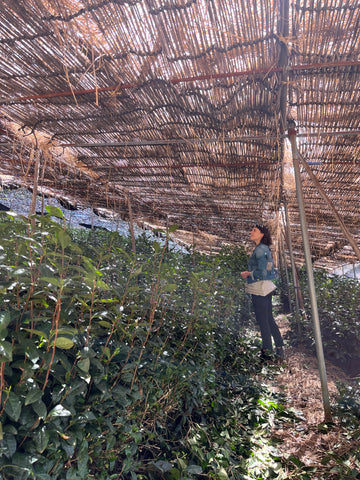 Lauren stands under traditional honzu shading -- quite rare these days!
Lauren stands under traditional honzu shading -- quite rare these days!
The shading time of a tea plant will affect different characteristics like flavor, aroma, caffeine level, and leaf size. Some types of Japanese tea, like gyokuro and matcha, require shading to produce distinct flavors and notes, while others don't require shading. We’ve written a deeper guide to shading tea – check out our article here.
How Different Types of Japanese Tea are Harvested
- Kabusecha: Kabusecha, a style of sencha, is shaded for 10-14 days before harvesting. A shorter shading time creates a tea with a bit of umami and a mix of sencha mellowness.
- Matcha: Tencha, the tea leaves that produce matcha, are shade-grown anywhere from 20- 50 days before harvest. The youngest and smallest two leaves of each shoot are picked.
- Gyokuro: Gyokuro is shaded for at least 20 days and handpicked once annually in late spring. The best three leaves are picked, which are the sweetest and highest in flavor, quality, and nutrients.
 Dento Hon Gyokuro ready to be plucked
Dento Hon Gyokuro ready to be plucked
As we learn more about green tea harvesting, let’s continue to appreciate the hard work, precise craft, and beauty that is Japanese green tea!
1 Response
Leave a comment
Comments will be approved before showing up.




Darrell
April 09, 2024
How do I get fresh green tea this time of year?